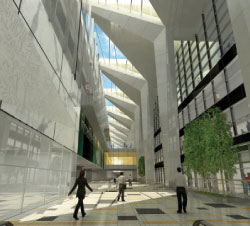
Arora: “The new terminal will be state-of-the-art – it will have 78 aerobridges and over 100 travelators. The terminal will be connected to the city through high speed Metro.”
Since 2006, the 30-year concession awarded to DIAL by the government to operate and modernise the airport has seen the start of what will be its most significant developments for growth – beginning this year and continuing in progressive phases until 2010, to coincide with the Commonwealth Games taking place in Delhi. The concession is extendable by a further 30 years. Among the wide-ranging projects, construction of a new Terminal 3 will enable the airport to be well-connected to the capital, with a high-speed metro already being built, along with ambitious plans for a new ‘hospitality district’ to serve tourists at the highly anticipated Commonwealth Games. The HOK-Mott MacDonald-Frischmann Prabhu team have been appointed by DIAL to undertake the master planning.
Third runway
The official opening of a third runway in September, the longest in operation at an Indian airport, fulfils a key requirement in the master plan to improve current capacity levels. “IGI had a capacity constraint. With the growth the Indian aviation sector was experiencing, the first step was to have sufficient and surplus capacity for meeting future demand,” said Arora.
HOK’s Richard Spencer, director, aviation and transportation, added: “The two existing runways at Delhi intersect and did not provide for independent operations. A new parallel runway was therefore key to increasing the airport’s capacity.”
Designed and built by DIAL, the runway is A380-compatible and Cat III B compliant, enabling landing during low visibility; it is good progress for the Consortium whose strategy rests on transforming IGI into a state-of-the-art travel hub.
“With enhanced runway capacity, the air congestion and delays have fallen substantially – meaning improved services to airlines and passengers,” said Arora.
The US$200 million (€155m) runway project has since increased the airport’s capacity from 40 to 60 flights per hour, added Arora. “Coupled with the upgrading of existing terminals and new domestic terminal, we will be able to increase this further.”
Upgrading works
Within the master plan, IGI is in the process of upgrading its existing terminals: two domestic terminals, as well as an international, cargo and a Haj Terminal. “We are also building a new domestic terminal with a capacity to handle 10 mppa. With these, the capacity of the airport will increase from the existing 12 mppa to 26 mppa by the first quarter of 2009,” said Arora. The reconfiguration of the domestic terminal complex aims to serve domestic traffic until 2010, including the low-cost carriers.
The International Terminal has now been upgraded; the passenger processing areas were reconfigured, signage and flight information and PA systems improved, alongside enhancements to the retail offering.
Terminal 3 project
Currently under construction, the new Terminal 3 has been designed in consultation with Mott Macdonald and HOK and will be completed early next year for operations in 2010.
For the first time, it will combine domestic and international traffic into one terminal with over 480,000sqm of floor space. Siemens will supply the baggage handling system and Indian contractor Larsen & Toubro Ltd has been appointed by GMR to assist with the design.
The scale of the project is significant – soon to be among the largest terminals in the world and over 90% of passengers passing through will be able to use an air bridge; 78 are to be installed. “The new terminal is positioned at the apex of the landside enclave between the runways to provide for efficient aircraft circulation and allow for modular expansion up to the ultimate capacity of the airport, which could become one of the busiest in the world,” said HOK’s Spencer.
Total capacity is expected to rise five-fold, from 12 million to 60 million; a much-needed boost for an airport, which has struggled with capacity issues, said Arora. “Traffic last year was 24 million so we were operating at 200% capacity.”
Terminal 3’s design lends itself to establishing Delhi airport as the new gateway to the capital. The main objectives are to provide international standards of space, clear way finding and natural light, with a focus on the arrival experience through a canyon in the centre of the building, which will create an impressive welcome to India, explained Spencer.
New connections

Spencer: “The main objectives are to provide international standards of space, clear wayfinding and natural light, with a focus on the arrival experience through a canyon in the centre of the building, which will create an impressive welcome to India.”
Simultaneous work is also underway on developing connectivity between the airport and the capital. A new high speed Metro system, currently under construction by Delhi Metro Rail Corporation and part funded by DIAL, will provide a direct link between Delhi’s main railway station and the airport. A new six-lane road from National Highway 8 will also vastly improve access within the airport’s vicinity.
Hospitality district – foreign investment
A 45-acre hotel district is also planned by private developers and forms part of IGI’s transition into a modern, world-class hub. “GMR has sought an expression of interest from potential Indian and international real estate investors to develop various categories of hotels and related facilities at Delhi airport. Bridges would connect five star, three star and seven star hotels and convention centres to the airport centre,” said Arora. “These projects will provide a fillip to aircraft and passenger traffic to the airport, promote economic growth in the region and create employment.”







